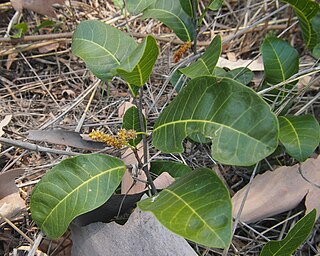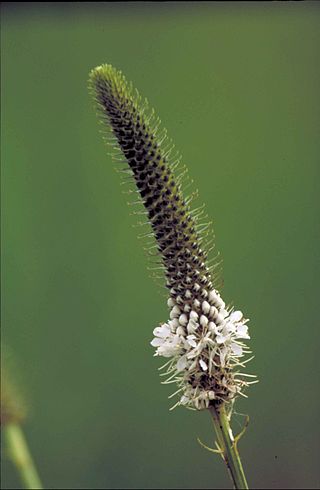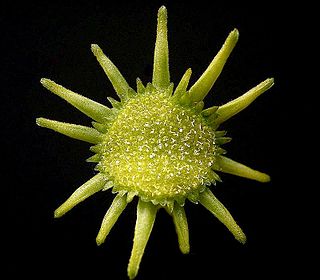
The Moraceae—often called the mulberry family or fig family—are a family of flowering plants comprising about 38 genera and over 1100 species. Most are widespread in tropical and subtropical regions, less so in temperate climates; however, their distribution is cosmopolitan overall. The only synapomorphy within the Moraceae is presence of laticifers and milky sap in all parenchymatous tissues, but generally useful field characters include two carpels sometimes with one reduced, compound inconspicuous flowers, and compound fruits. The family includes well-known plants such as the fig, banyan, breadfruit, jackfruit, mulberry, and Osage orange. The 'flowers' of Moraceae are often pseudanthia.

Boraginaceae, the borage or forget-me-notfamily, includes about 2,000 species of shrubs, trees, and herbs in 146 to 154 genera with a worldwide distribution.

Trophis is a genus in the plant family Moraceae which includes five species native to the tropical Americas, ranging from Mexico through Central America and the Caribbean to Peru and northern Brazil. It is dioecious, with male and female flowers borne on separate plants.

Brosimum is a genus of plants in the family Moraceae, native to tropical regions of the Americas.

Dalea is a genus of flowering plants in the legume family, Fabaceae. Members of the genus are commonly known as prairie clover or indigo bush. Its name honors English apothecary Samuel Dale (1659–1739). They are native to the Western hemisphere, where they are distributed from Canada to Argentina. Nearly half of the known species are endemic to Mexico. Two species of Dalea have been considered for rangeland restoration.

Helicostylis is a genus of flowering plants in the mulberry family, Moraceae. It includes eight species native to the tropical Americas, ranging from Costa Rica to Bolivia and southeastern Brazil.

Henriettea is a genus of flowering plants in the family Melastomataceae, with some 399 species accepted. It is distributed in the Americas. Some species in the genus are known commonly as camasey., though the common name camasey may also refer to plants of genus Miconia.
Naucleopsis is a genus of flowering plants in the mulberry family, Moraceae. It includes 25 species native to the tropical Americas, ranging from Honduras to Bolivia and southeastern Brazil.

Pseudolmedia is a flowering plant genus in the mulberry family (Moraceae). Species are found in southern Mexico, the Caribbean, and Meso- and South America. They are known in Latin America as lechechiva and used for timber, construction wood, and sometimes in folk medicine.

Tapura is a genus of plant in the family Dichapetalaceae.

Antiaris toxicaria is a tree in the mulberry and fig family, Moraceae. It is the only species currently recognized in the genus Antiaris. The genus Antiaris was at one time considered to consist of several species, but is now regarded as just one variable species which can be further divided into five subspecies. One significant difference within the species is that the size of the fruit decreases as one travels from Africa to Polynesia. Antiaris has a remarkably wide distribution in tropical regions, occurring in Australia, tropical Asia, tropical Africa, Indonesia, the Philippines, Tonga, and various other tropical islands. Its seeds are spread by various birds and bats, and it is not clear how many of the populations are essentially invasive. The species is of interest as a source of wood, bark cloth, and pharmacological or toxic substances.

Treculia is a genus of trees in the plant family Moraceae that is native to west and central Africa and Madagascar. The best-known member of the genus, Treculia africana, commonly known as the African breadfruit, is used as a food plant.

Moreae is a tribe within the plant family Moraceae. It includes 6–10 genera and 70–80 species, including Morus, the genus that includes the mulberries, and Maclura, the genus that includes the Osage orange.

Dorstenia is a genus within the mulberry family, Moraceae. Depending on the author, there are said to be 100 to 170 species within this genus, second only in number to the genus Ficus within Moraceae. Plants of the World Online currently accepts 122 species. Dorstenia species are mainly known for their unusual inflorescences and growth habits. Dorstenia is named in honor of the German physician and botanist Theodor Dorsten (1492–1552). The type species is Dorstenia contrajerva.
Antiaropsis is a genus of flowering plants belonging to the family Moraceae. It is dioecious, with male and female flowers borne on separate plants.

Coussapoa is a genus of flowering plants belonging to the family Urticaceae.
Hijmania is a genus of flowering plants in the mulberry family, Moraceae. It includes four species of shrubs and subshrubs native to tropical Africa, ranging from Guinea in the west through west and west-central Africa to Kenya and Tanzania in east Africa.














